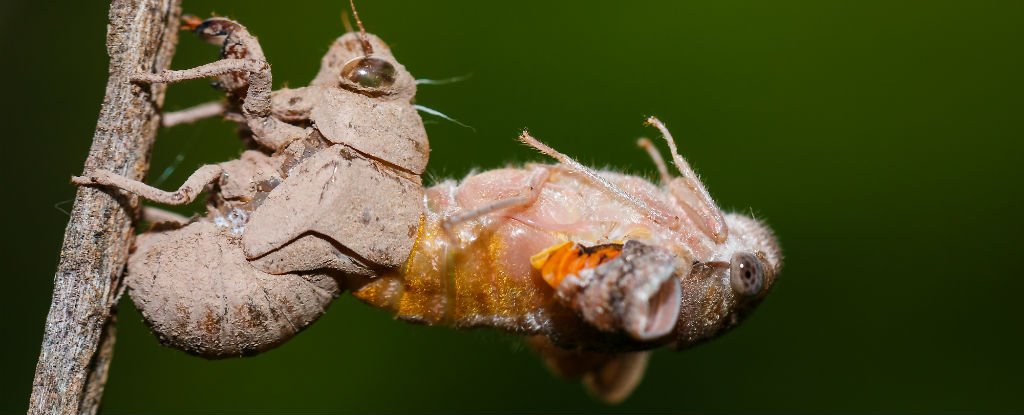Products You May Like
If any animal were said to be born from Earth’s belly, it might as well be the periodical cicada.
The synchronized mass ‘birth’ of this incredible insect is one of the greatest unsolved mysteries of the natural world.
In North America, broods of juvenile cicadas, called nymphs, quietly develop underground in the soil, suckling sap via the roots of trees.
Attached to this ‘umbilical cord’, the winged bugs can spend as long as thirteen or seventeen years developing (depending on the species), before finally entering the world above.
What’s even stranger is that every individual in a regional brood is ‘born’ at roughly the same time, ‘screaming’ like babies – not for their mothers, but for potential mates.
In 2020, more than a million cicadas burst from the underground after 17 years in Southwest Virginia, parts of North Carolina, and West Virginia, creating a cacophony.
A few months later, all was silent again. The insects had mated and died, and the next generation were already developing underground, not to emerge until 2037.
Despite the fact that periodical cicadas (of the genus Magicicada) are among the most studied insects in evolution and ecology, no one knows how or why they do this.
The temperature of the soil and the nutrients the nymphs get from tree roots could clue them in to the passing seasons, but this is only relevant to a single year underground. How do they count up to 17?
“It is entirely unclear how their periodical life cycles are controlled,” wrote zoologist Teiji Sota in a 2022 paper on periodical cicadas.
No other animal has such a long, fixed, synchronized life cycle where reproduction occurs en masse and only once in a lifetime.
So why does the cicada?
One leading theory is that the cicada’s extreme lifecycle helps reduce predation. By spending up to 99.5 percent of its life underground as a nymph, defenseless and clumsy adults avoid exposing themselves to predators like reptiles, birds, and small and large mammals.
In this case, finding a mate is much easier and safer if all the insects emerge around the same time.
But Magicicada aren’t the only cicadas that face the risk of predators, so why is their lifestyle so rare?
Some scientists think temperature could play a key role.
In cold environments, models show that “extremely long juvenile stages lead to extremely low adult densities, limiting mating opportunities and favoring the evolution of synchronized emergence”.
Perhaps the cicada lifestyle is an evolutionary remnant of much colder times.
With global warming, scientists have noticed that some cicadas are emerging four years earlier than usual.
But here’s where the whole mystery gets really curious. A brood’s lifecycle can be adjusted.
The adult metamorphosis of Magicicada, of which there are seven species, is flexible give or take four years.
This means that adults tend to emerge in late April to early June at 9, 13, 17, or 21 years of age, depending on the species. But how does a brood all know when to call it early? Or to chill out a bit longer?
Perhaps they hit a critical weight or developmental milestone that kicks them into adulthood.
Or maybe they have a 4-year biological clock of some sort that reassesses the creature’s developmental state on a regular cycle.
Sota thinks it’s a mix of all those factors.
“In essence,” he wrote, “the timing of adult emergence (metamorphosis) is assumed to be determined by the interaction of the internal clock, genetically determined growth rate, and critical body weight.”
More genome studies are needed to support that hypothesis, but based on recent progress, Sota thinks the mystery of the Magicicada will be solved in the next decade.
